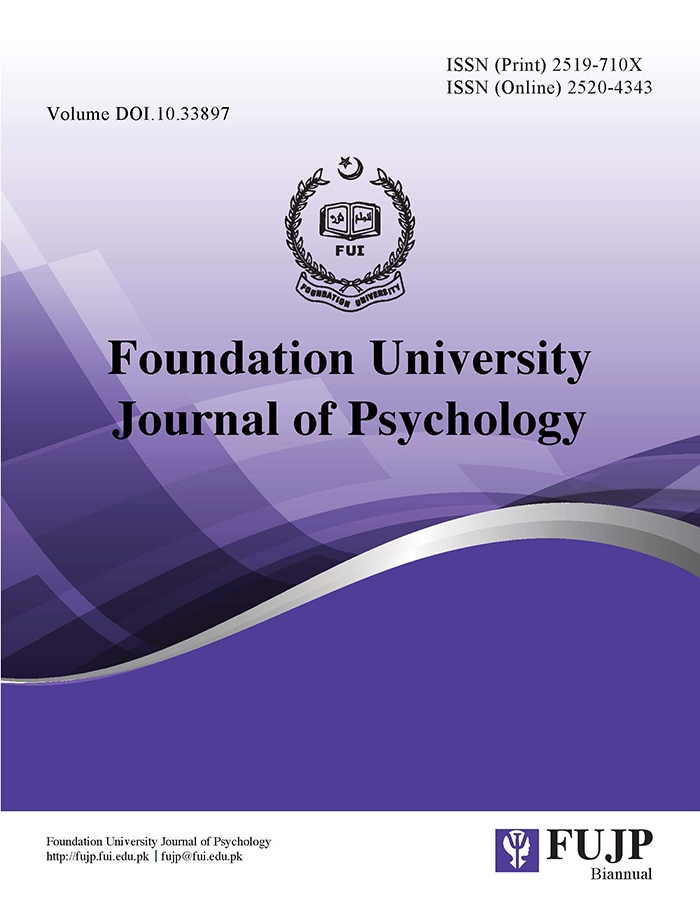Common Myths About Coronavirus Disease-19 ( COVID-19) Among Adults
DOI:
https://doi.org/10.33897/fujp.v5i2.377Keywords:
Pandemic, COVID-19, Myths, Pakistan, PrevalenceAbstract
Objective. People adopted different attitudes and behaviors during the outbreak of COVID19
pandemic. It results in development of various myths among the peoplewhichalso effect adoption of
precautionary measures. The present study thus attempted to assess common myths related to
COVID-19 in Pakistan among general population of adults.
Method. A list of 33 myths was generated based on literature, opinion of subject matter experts, and
general observation of myths prevailing in Pakistan. It was used to assess myths about COVID-19 for
the sample (N=220) of adults (Mage=27.9; SDage=10.2).
Results. Results suggested that the most prevalent myths are:(a)older people are more vulnerable to get
infected of COVID-19 (82%) and (b) thermal scanners can detect if the person is infected of virus
(75%). Participants also mention some associated indigenous myths e.g., COVID-19 doesn’t prevail,
deaths are misreported as caused by Corona virus, and Corona recovered people can’t get infected again
etc. Results of t-test suggested that men are stronger myths believers as compared to women.
Differences with respect to education demonstrated that undergraduates and graduates are significantly
higher believers of myth than postgraduates.
Implications. Findings could help to develop a clear awareness of the false beliefs about COVID-19.
Addressing the false beliefs would assist in ensuring the adoption of necessary precautionsas beliefs
closely associate with preventive measures adopted.
Downloads
References
Carbone, M., Green, J. B., Bucci, E. M., & Lednicky, J. A. (2020). Coronaviruses: Facts, myths, and hypotheses. Journal of Thoracic Oncology, 15(5), 675-678. https://doi.org/ 10.1016/j.jtho.2020.02.024.
Chen, N., Zhou, M., Dong, X., Qu, J., Gong, F., Han, Y., ... Yu, T. (2020). Epidemiological and clinical characteristics of 99 cases of 2019 novel coronavirus pneumonia in Wuhan, China: A descriptive study. The Lancet, 395(10223), 507-513. https://doi.org/10.1016/ S0140-6736(20)30211-7.
De Vellis, R. F. (2016). Scale Development: Theory and Applications (Vol. 26). California: SAGE Publications.
Field, A. (2018). Discovering Statistics Using IBM SPSS Statistics (5th ed., pp. 1050-1054). California: Sage Publishers.
Gupta, S., Raghuwanshi, G. S., & Chanda, A. (2020). Effect of weather on COVID-19 spread in the US: A prediction model for India in 2020. Science of the Total Environment, 728(1), 1-8. https://doi.org/10.1016/j.scitotenv.2020.138860.
Holshue, M. L., DeBolt, C., Lindquist, S., Lofy, K. H., Wiesman, J., Bruce, H., ... Diaz, G. (2020). The first case of the 2019 novel coronavirus in the United States. The New England Journal of Medicine, 382(10), 929-936. https://doi.org/10.1056/NEJMoa2001191.
Jami, H. (2012). Attitude Towards Hijras and Their Reciprocal Perceptions (unpublished Doctoral dissertation). National Institute of Psychology, Quaid-i-Azam University, Islamabad, Pakistan.
Khalid, A., & Ali, S. (2020). COVID-19 and its challenges for the healthcare system in Pakistan. Asian Bioethics Review, 1-14. http://doi.org/10.1007/s41649-020-00139-x.
Mwamwenda, T. S. (2015). Myths and misconceptions regarding global pandemic HIV/AIDS. Life Science Journal, 12(S2), 117-124. https://doi.org/10.7537/marslsj1202s15.19.
Naqvi, I. (2017). Eating Attitudes and Beliefs in Food Myths Among Adolescents (unpublished Doctoral dissertation). National Institute of Psychology, Quaid-i-Azam University, Islamabad, Pakistan.
Poole, D. N., Escudero, D. J., Gostin, L. O., Leblang, D., & Talbot, E. A. (2020). Responding to the COVID-19 pandemic in complex humanitarian crises. International Journal for Equity in Health, 19(1), 1-2. https://doi.org/10.1186/s12939-020-01162-y
Sahoo, S., Padhy, S. K., Ipsita, J., Mehra, A., & Grover, S. (2020). Demystifying the myths about COVID-19 infection and its societal importance. Asian Journal of Psychiatriary, 54(1), 1-7. https://doi.org/10.1016/j.ajp.2020.102244.
Sajadi, M. M., Habibzadeh, P., Vintzileos, A., Shokouhi, S., Miralles-Wilhelm, F., & Amoroso, A. (2020). Temperature and latitude analysis to predict potential spread and seasonality for COVID-19 [Abstract]. https://ssrn.com/abstract=3550308.
Sohrabi, C., Alsafi, Z., O’Neill, N., Khan, M., Kerwan, A., Al-Jabir, A., ... Agha, R. (2020). World Health Organization declares global emergency: A review of the 2019 novel coronavirus (COVID-19). International Journal of Surgery, 76(1), 71-76. https://doi.org/ 10.1016/j.ijsu.2020.02.034.
Tomar, A., & Gupta, N. (2020). Prediction for the spread of COVID-19 in India and the effectiveness of preventive measures. Science of Total Environment, 728(1), 1-6. https://doi.org/10.1016/j.scitotenv.2020.138762.
Van Reeth, K., Van Poucke, S., & De Vleeschauwer, A. (2009, September). Pigs and pandemic influenza: Myths versus facts. Paper presented at the Allen D. Leman Swine Conference, University of Minnesota, Minneapolis, Minnesota.
Waqar, S. (2015). Career Beliefs, Personality, and Career Success: An Investigation of Direct and Indirect Effects (unpublished Doctoral dissertation). National Institute of Psychology, Quaid-i-Azam University, Islamabad, Pakistan.
Wise, T., Zbozinek, T. D., Michelini, G., Hagan, C. C., & Mobbs, D. (2020). Changes in risk perception and protective behavior during the first week of the COVID-19 pandemic in the United States. PsyArXiv Preprint. https://doi. org/10.31234/osf. io/dz428.
World Health Organization. (2008). International Health Regulations-2005 (2nd ed.). Geneva: Author.
World Health Organization. (2020). Protocol for the assessment of potential risk factors for coronavirus disease 2019 (COVID-19) among health workers in a health care setting [Report No. WHO/2019-nCoV/HCW_risk_factors_protocol/2020.3].
World Health Organization. n.d. Coronavirus disease (COVID-19) advice for the public: Mythbusters [Web log post]. Retrieved from https://www.who.int/emergencies/diseases/novel-coronavirus-2019/advice-for-public/myth-busters.



